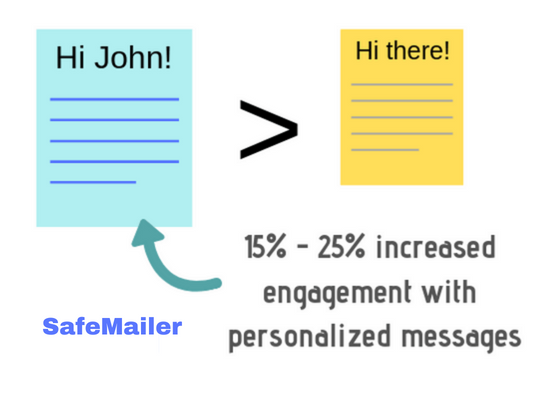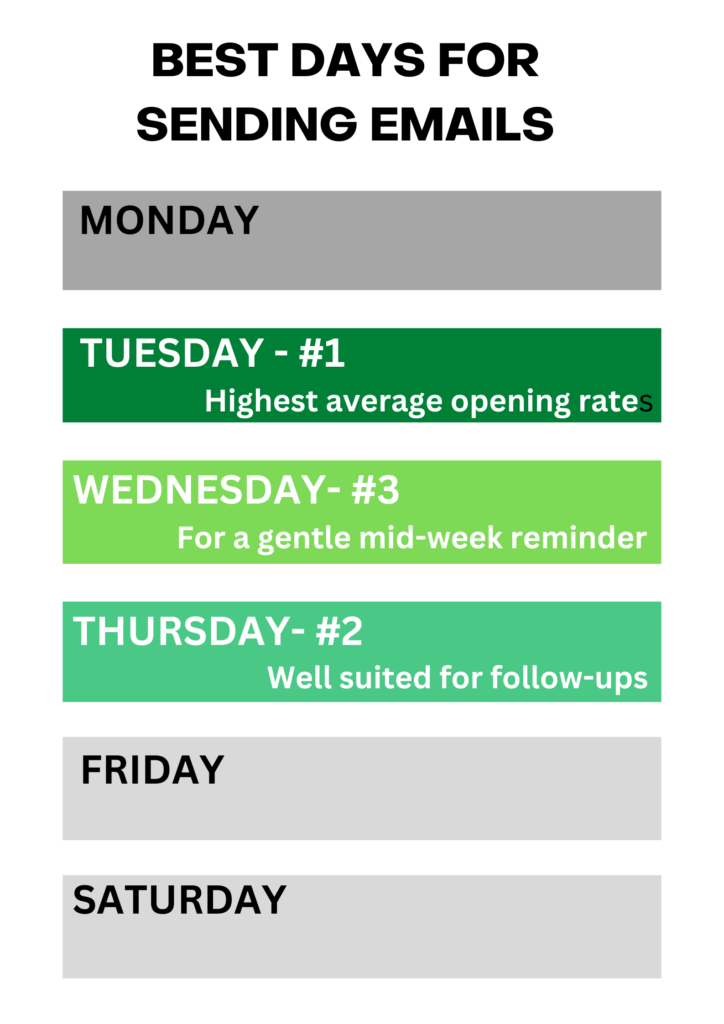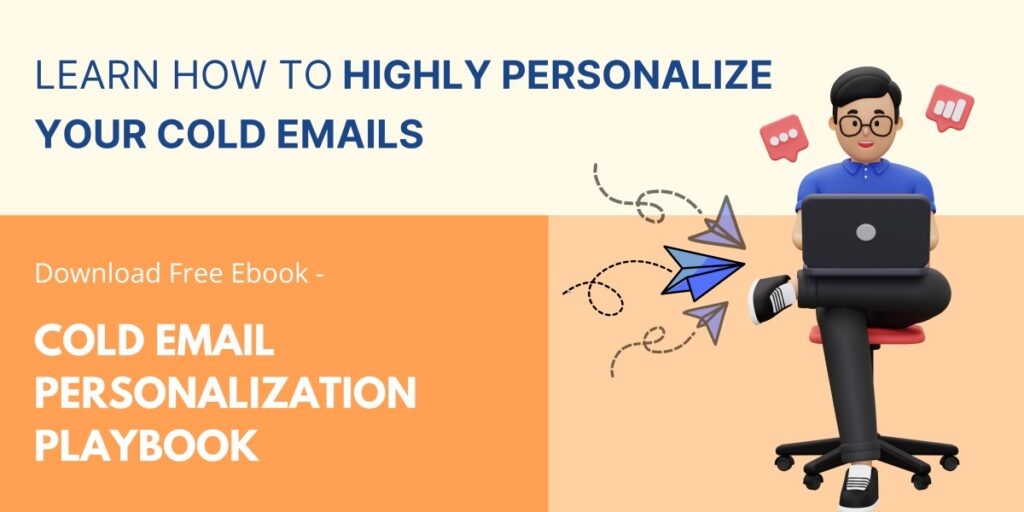Without a doubt, personalization is a fantastic way to cultivate trust among your subscribers and establish enduring connections with your customers.
But imagine receiving emails from a brand like:
A simple “hi”, Hey, {fisrt_name}, OR
Receiving suggestions on Men’s fashion wear even though you signed up for women’s fashion wear.
Sounds annoying, isn’t it?
Well, the good thing here is the brand is making use of personalization. But, in the wrong way!
This will definitely cost them their leads as well as hamper their brand image and hence avoiding such mistakes is crucial.
In this article, we will explore these mistakes and provide you with valuable insights on how to avoid them.
So, let’s dive in!
Email Personalization Mistakes You Should Avoid
According to Campaign Monitor, personalized messages receive 15-25% more engagement.

So, to ensure you make the most out of email personalization, it’s essential to avoid these common mistakes:
1. Operating without an Overall Email Personalization Strategy
One of the most significant mistakes that marketers make in email personalization is operating without a well-defined strategy.
Without a well-defined plan in place, they risk sending out messages that lack relevance and consistency.
Receiving such messages disappoints the users ultimately leading to no engagement rate.
To avoid this, it is essential to develop a comprehensive email personalization strategy that aligns with your marketing goals and target audience.
The solution:
A robust email personalization strategy should include:
- Segmentation: Segmentation involves dividing your audience into distinct groups based on specific criteria such as demographics, behavior, or purchase history. By categorizing your subscribers, you can deliver tailored messages that address their unique needs and preferences.
- Data Collection: To personalize emails effectively, you need accurate and relevant data. Implement mechanisms to collect customer data, such as preferences, interests, and demographics. This data will serve as the foundation for personalization and enable you to craft highly targeted and engaging emails.
- Dynamic Content: Dynamic content allows you to customize various elements within your emails based on recipient data. By utilizing dynamic tags and variables, you can personalize aspects such as product recommendations, greetings, and offers. This level of customization enhances the recipient’s experience and increases the likelihood of conversions.
- Testing and Optimization: Continuously test and optimize your email personalization efforts. Conduct A/B tests to evaluate different variables and assess their impact on open rates, click-through rates, and conversions. Regularly analyze the results to refine your personalization strategy and ensure optimal performance.
2. Sending a Message with a Bad Variable Name
Have you ever experienced the embarrassment of mistakenly sending an email that begins with “Hi #firstname#” instead of addressing the recipient by their actual name?
It’s a frequent error that can potentially damage your relationship with your subscribers. Fortunately, there’s a straightforward way to avoid this mistake and maintain a positive connection with your audience.
The solution:
When creating variable names, follow these best practices:
- Ensure variable names are clear, concise, and relevant to the information they represent.
- Send a test email to your own email ID first.
- Use naming conventions that are easy to understand and follow.
- Avoid ambiguous or generic terms that could lead to confusion.
- Regularly review and validate variable names to ensure accuracy and consistency.
- By implementing these guidelines, you can minimize the risk of errors and provide accurate personalization in your email communications.
3. Sending a Blank Value
Have you ever sent an email that had blank fields instead of personalized information? It’s another common blunder in email personalization that can make your messages seem generic and careless.
To avoid this, it is essential to validate and verify data before sending personalized emails.
The solution:
Consider the following measures to prevent sending blank values:
- Implement robust data validation processes to ensure all required fields are populated.
- Regularly review and update your data collection methods to capture complete and accurate information.
- Set up safeguards in your email marketing platform to identify and exclude emails with missing or incomplete data from being sent.
- By adhering to these practices, you can enhance the quality of your personalized emails and provide a seamless user experience.
4. Over-segmenting your Customer Base
While segmentation is valuable for targeted personalization, over-segmentation can hinder your email marketing efforts.
Overly granular segments can lead to small audience sizes, resulting in reduced engagement and limited campaign effectiveness.
To avoid this, strike a balance between segmentation and audience size.
The solution:
Consider the following tips for effective segmentation:
- Define segments based on relevant criteria that align with your marketing goals.
- Consolidate smaller segments with similar characteristics to create larger, more impactful audience groups.
- Regularly evaluate and refine your segments based on performance metrics and evolving customer behaviors.
- By optimizing your segmentation strategy, you can deliver personalized content to a substantial audience without sacrificing relevance.
5. Sending to an Incorrect Segment
Segmentation plays a vital role in managing email campaigns effectively. Your customers and subscribers have unique preferences and they expect content that is tailored to their interests.
So, sending personalized emails to the wrong segment can damage your brand’s reputation and undermine your marketing efforts.
Hence, it’s crucial to double-check and verify the recipient’s segment before sending any personalized emails.
The solution:
- To mitigate this mistake, implement robust quality assurance processes in your email marketing workflows.
- Clearly define the criteria for each segment and verify the accuracy of your segmentation before executing your campaigns.
- Regularly review and update your segment definitions to account for changes in customer behavior and preferences.
6. Irrelevant Product Recommendations
When it comes to email personalization, one of the key benefits is the opportunity to offer customers tailored product recommendations. But imagine receiving an email promoting products that have nothing to do with your preferences or previous purchases.
It can be frustrating, right?
You might even question why you’re receiving such recommendations in the first place. This disconnect between the customer’s expectations and the actual recommendations can lead to disengagement and, ultimately, a negative impact on your relationship with them.
To avoid this mistake, it’s crucial to ensure the accuracy and relevance of your product recommendations.
The solution:
Take the time to analyze each customer’s browsing history, purchase behavior, and preferences. By understanding their unique tastes and needs, you can provide recommendations that genuinely resonate with them. Remember, the goal is to enhance the customer experience and create a sense of personalized care, not to overwhelm them with unrelated products.
7. Sending at the Wrong Time
No matter how well-crafted your email is, its success greatly depends on the timing of its delivery. If you send it at the wrong time or on the wrong day, there’s a high chance it’ll go unopened or even end up in the trash folder. Ultimately wasting all your effort just because it didn’t arrive when your subscribers were ready to engage.
To ensure your emails get the attention they deserve, it’s crucial to send them at the right time and on the right day, when your subscribers are most likely to open and read them. The following are the best days to send emails.

The solution:
- To optimize the timing of your emails, analyze your audience’s behavior patterns and preferences.
- Consider factors such as time zones, historical engagement data, and open rates to determine the most suitable time to send your emails.
- Experiment with different send times and days and measure the impact on engagement metrics to refine your approach.
8. Not Including Dynamic Content in General Email Campaigns
While it’s important to personalize your email campaigns, it’s equally crucial to include dynamic content in broader email initiatives. Many businesses focus solely on targeted personalized campaigns and overlook the importance of dynamic content in general email communications. This harms your email campaign success rate drastically.
The solution:
To avoid this mistake, incorporate dynamic content elements such as personalized greetings, location-based offers, and relevant blog content in your general email campaigns.
This approach ensures that even recipients who don’t fall into specific segments still receive a personalized experience, increasing their engagement and fostering a positive brand perception.

Conclusion
Email personalization can do wonders for your business if done correctly. By avoiding the common mistakes outlined in this article, you can deliver highly relevant and impactful email experiences to your subscribers.
A cold email automation tool like SafeMailer can help you simplify your efforts. All you need to do is insert the correct variables within the hashtag syntax directly from your Spreadsheet.
With these practices in place, you’ll be well-equipped to maximize the potential of email personalization and achieve outstanding results in your email marketing campaigns.
TL;DR:
Email personalization is essential for successful marketing, but many marketers make avoidable mistakes.
To ensure effective personalization, have a clear strategy, use accurate data, and include dynamic content.
- Avoid errors like sending emails with bad variable names or blank values.
- Be cautious with segmentation, as over-segmenting can backfire.
- Double-check the right segment before sending personalized emails.
- Provide relevant product recommendations by understanding customers’ preferences.
- Send emails at the right time to increase engagement.
- Don’t forget to use dynamic content in general email campaigns for a personalized experience.
By avoiding these mistakes, you can achieve better results and build stronger relationships with your audience. Consider using tools like SafeMailer to simplify your personalization efforts and deliver impactful email campaigns.

Leave a Reply